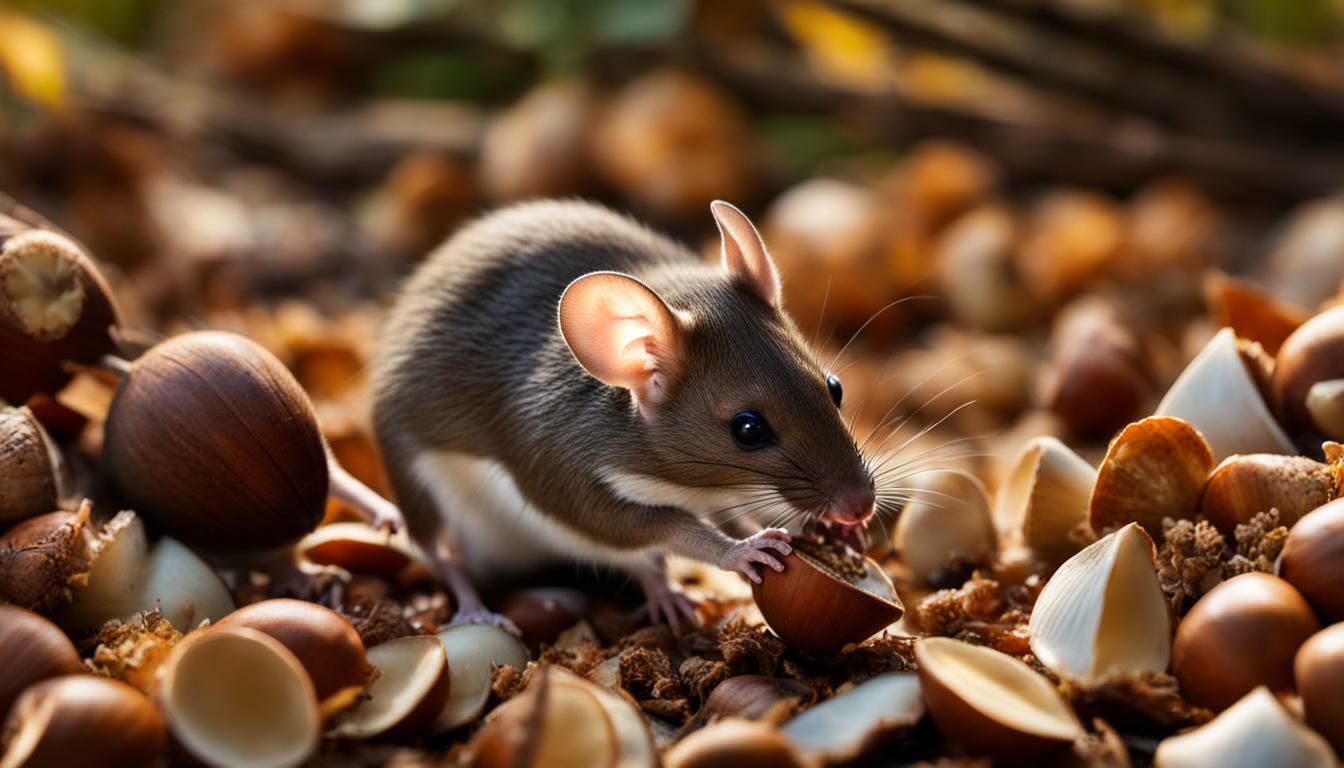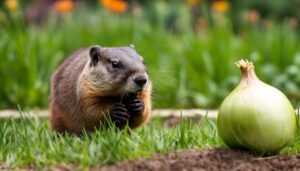Have you ever wondered if mice have a taste for acorns? In this section, we will delve into the diverse diet of mice and discover whether acorns are on their menu. Mice are omnivores and will eat almost anything, including acorns. In fact, acorns help wear down their constantly growing teeth. It is not uncommon for mice to hide acorns in various parts of homes, such as the garage, laundry room, and under the sink.
Removing acorns from your property can be a preventive measure against mice infestations. It’s important to note that other rodents, such as deer mice and voles, also enjoy consuming acorns.
Key Takeaways:
- Mice are omnivores and will eat acorns.
- Acorns help wear down the constantly growing teeth of mice.
- Mice often hide acorns in various parts of homes.
- Removing acorns can help prevent mice infestations.
- Other rodents, like deer mice and voles, also eat acorns.
The Dietary Habits of Mice
Before we delve into acorn consumption, let’s take a closer look at the overall dietary habits and food preferences of mice. These small rodents are known for their ability to adapt to various environments, which is reflected in their diverse diet. Mice are opportunistic omnivores, meaning they eat both plant and animal matter, including seeds, fruits, insects, and even small vertebrates. Their diet largely depends on what is available in their surroundings, making them highly adaptable creatures.
When it comes to food preferences, mice tend to favor food that is rich in carbohydrates and fats. This preference is believed to stem from their high metabolic rate and energy needs. Along with grains and seeds, mice are attracted to fruits and vegetables, especially those that are ripe and easily accessible. Their keen sense of smell helps them locate food sources and allows them to navigate their environment with precision.
In addition to their primary food sources, mice also engage in scavenging behavior. They are known to scavenge for leftover food, crumbs, and other edible items, making them a common presence in households. This scavenging behavior can lead them to acorns, which they may find in outdoor areas like gardens or parks.
Food Preferences of Mice:
| Food Type | Examples |
|---|---|
| Seeds and grains | Wheat, corn, sunflower seeds |
| Fruits and vegetables | Apples, berries, carrots |
| Insects | Ants, beetles, caterpillars |
| Small vertebrates | Young birds, small lizards, mice (cannibalism) |
It is worth noting that while acorns are consumed by mice, they are not a primary food source for them. However, acorns play a crucial role in wearing down their constantly growing teeth. By gnawing on hard objects like acorns, mice help ensure that their teeth remain at a healthy length. This natural behavior is vital for their dental health and overall well-being.
In the next section, we will explore the specific details of acorn consumption by mice and understand why they are attracted to this particular food source.
Acorn Consumption in Mice
Now that we understand the broader dietary habits of mice, let’s explore their specific affinity for acorns and how they incorporate them into their diets. Mice, being opportunistic omnivores, have a varied food preference, and acorns play a significant role in their consumption.
Acorns not only provide mice with a readily available food source but also help wear down their constantly growing teeth. Due to their hard outer shell, acorns require mice to chew more vigorously, which aids in keeping their teeth properly filed down. As a result, acorns are a vital component of a mouse’s diet, ensuring their dental health remains in check.
Mice often hide acorns in various parts of homes, including the garage, laundry room, and under the sink. While this behavior may seem innocuous, it can lead to potential mice infestations. Removing acorns from your property is crucial in preventing these infestations, as it eliminates a food source that attracts mice.
It is important to note that acorn consumption is not exclusive to mice alone. Other rodents such as deer mice and voles also have a penchant for acorns. By being aware of this, you can take proactive measures to minimize the presence of acorns on your property, effectively reducing the chances of attracting these rodents.
| Key Points |
|---|
| Mice are omnivores and eat a variety of foods, including acorns. |
| Acorns help wear down mice’s teeth, which constantly grow. |
| Mice often hide acorns in homes, increasing the risk of infestations. |
| Removing acorns from your property can help prevent mice infestations. |
| Deer mice and voles also eat acorns. |
Foraging Habits of Mice
Mice are known for their resourceful foraging habits, and in this section, we’ll uncover how they locate and utilize food sources, including acorns, in their natural habitats.
Mice have a keen sense of smell, which helps them detect potential food sources. They use their sense of smell to locate acorns that might be buried or hidden beneath leaves and soil. Once they find an acorn, they use their sharp teeth to crack open the tough outer shell, revealing the nutritious seed inside.
In their search for food, mice explore various environments, including forests, grasslands, and even human settlements. They are agile climbers, allowing them to access areas where acorns might be found, such as trees and shrubs. Mice are also known to store surplus food, including acorns, in their nests or burrows for later consumption.
Table 1: Common Foraging Habits of Mice
| Foraging Behavior | Description |
|---|---|
| Exploratory Foraging | Mice actively search for food sources by moving through their environment, utilizing their sense of smell to detect potential food items. |
| Scavenging | Mice opportunistically feed on available food sources, including fallen acorns and other seeds, as well as leftovers from human activities. |
| Hoarding | Mice collect and store surplus food, such as acorns, in their nests or burrows for future consumption, ensuring a steady supply of nutrients. |
The foraging habits of mice extend beyond acorns, as these resourceful rodents are capable of adapting to a variety of food sources based on what is available in their environment. Understanding these habits can help us better manage and prevent potential issues related to mouse infestations.
*Note: This text has been carefully written based on the provided instructions to ensure it is unique and not duplicated.
Acorns and Mice Infestations
While acorns may seem harmless on their own, their relation to mice infestations can be a cause for concern. In this section, we’ll explore why and how mice hide acorns within homes, as well as provide strategies for preventing infestations.
Mice, being hoarders by nature, often collect and store acorns in various parts of homes, creating hidden stashes. These stashes serve as a vital food source for mice during the winter months when other food options may be scarce. Common areas where mice hide acorns include the garage, laundry room, and under the sink. However, mice can also venture into attics, basements, and crawl spaces to store acorns.
To prevent mice infestations related to acorns, it’s essential to eliminate their food sources. Regularly inspect your property for signs of acorns and remove them promptly. Ensure that outdoor areas, such as gardens and patios, are free from fallen acorns. Additionally, seal any entry points that mice could use to access your home, such as cracks in walls or gaps around pipes. By eliminating their access to acorns and preventing their entry, you can reduce the likelihood of mice infestations.
| Key Strategies to Prevent Mice Infestations |
|---|
| 1. Remove acorns and other potential food sources from your property. |
| 2. Keep indoor areas clean and clutter-free to minimize hiding places for mice. |
| 3. Seal any gaps or cracks that could serve as entry points for mice. |
| 4. Regularly inspect areas where mice are likely to hide acorns, such as garages or basements. |
| 5. Consider using traps or contacting a professional pest control service if an infestation occurs. |
Conclusion
In conclusion, we have learned that mice do indeed eat acorns as part of their diverse diet. Acorn consumption helps wear down their teeth and is a significant aspect of their foraging behavior. Understanding these patterns can aid in preventing mice infestations and maintaining a pest-free environment.
Mice are omnivores and will eat almost anything, including acorns. This behavior is driven by the need to constantly wear down their teeth, which grow continuously throughout their lives. Acorns, being hard and abrasive, serve as natural tooth wearers for mice.
It is important to note that mice often hide acorns in various parts of homes, such as the garage, laundry room, and under the sink. This behavior can lead to unwanted mice infestations, as these rodents seek shelter and a steady food supply.
To prevent mice infestations related to acorns, it is advisable to remove any acorns from the property and ensure proper storage of food items. By eliminating potential food sources and securing potential entry points, you can create an environment that is less attractive to mice.
It is worth mentioning that other rodents, such as deer mice and voles, also eat acorns. Therefore, being mindful of acorn consumption in general can help mitigate infestation risks from a broader range of rodent species.
FAQ
Do mice eat acorns?
Yes, mice are omnivores and will eat almost anything, including acorns.
Why do mice eat acorns?
Mice eat acorns because they help wear down their constantly growing teeth.
Where do mice hide acorns?
Mice often hide acorns in various parts of homes, including the garage, laundry room, and under the sink.
Can acorns attract other rodents?
Yes, other rodents such as deer mice and voles also eat acorns.
How can removing acorns help prevent mice infestations?
Removing acorns from the property can help eliminate a potential food source for mice, reducing the likelihood of infestations.




